Supplementary Supporting Statement Part A
0218 - Supplemental Supporting Statement A for ARMS II 2019.docx
Agricultural Resource Management and Chemical Use Surveys
Supplementary Supporting Statement Part A
OMB: 0535-0218
SUPPORTING STATEMENT Part A
ARMS II and Fruit Chemical Use Survey
Substantive Change
OMB No. 0535-0218
This substantive change is being submitted as a supplemental supporting statement to the List Sampling Frame Survey.
A. JUSTIFICATION
Circumstances making collection of information necessary.
NASS is requesting a substantive change to the ARMS and Chemical Use Survey docket (0535-0218) to accommodate changes to several of the questionnaires.
NASS was approached by the Office of Pest Management Policy (OPMP) through a cooperative agreement to make changes to the ARMS II and Fruit Chemical Use surveys for 2019.
The OPMP was created by the Agricultural Research, Extension, and Education Reform Act of 1998 in response to grower concerns about the implementation of the Food Quality Protection Act of 1996 (FQPA). By 1998 statute, and as reauthorized in the Agricultural Act of 2014 (P.L. 113-79), OPMP “shall be responsible for
the development and coordination of Department policy on pest management and pesticides;
the coordination of activities and services of the Department, including research, extension, and education activities, regarding the development, availability, and use of economically and environmentally sound pest management tools and practices;
assisting other agencies of the Department in fulfilling their responsibilities related to pest management or pesticides under the Food Quality Protection Act of 1996, the Federal Food, Drug and Cosmetic Act and other applicable laws;
perform other functions as required by law of by request of the Secretary;
ensure coordination of interagency activities with EPA and FDA and other Federal and state agencies; and
consult with agricultural producers that may be affected by pest management or pesticide-related activities or actions of the Department or other agencies.”
The additional questions that will be added to the questionnaires will address the following topics:
Growers practices used to reduce off-field pesticide drift,
Growers participation in programs to manage pesticide drift,
Grower decisions regarding application methods, nozzle choices, and spray tank management,
Sources of information growers are using to inform their pest resistance management decisions,
Grower practices employed to manage pesticide resistance,
Grower Best Management Practices (BMPs) to prevent pesticide exposure to pollinators,
Grower awareness of BMPs to prevent pesticide exposure to pollinators.
How, by whom, and for what purpose information is to be used.
OPMP will be able to use the expanded NASS data to better fulfil their responsibilities listed above.
Use of improved information technology.
The ARMS II and Fruit Chemical Use Surveys are done by field enumeration. These changes to the questionnaires will not change anything as far use of technology.
4. Efforts to identify duplication.
There are no changes from the original approval related to duplication reduction.
Methods to minimize burden of small businesses.
NASS incorporated additional screening questions and skip patterns to help minimize additional burden as much as possible.
Consequence if information collection were less frequent.
There are no changes to the frequency of these surveys than was originally approved.
Special circumstances.
No special circumstances are associated with this information collection.
Federal register notice and consultation with outside persons.
Not applicable.
Payments or gifts to respondents.
No payments or gifts will be given to respondents.
Confidentiality provided to respondents.
Confidentiality will be provided to respondents in accordance with the Confidential Information Protection and Statistical Efficiency Act (CIPSEA) of 2002. All confidentially protections that are applied to all products released from these surveys will remain the same as originally approved.
Questions of a sensitive nature.
No questions of sensitive nature will be asked.
12. Hour burden and annualized costs to respondents.
The following table contains the estimated burden hours for the surveys included in this supplemental supporting statement. Cost to the public for completing the questionnaire is assumed to be comparable to the hourly rate of those requesting the data. The adjusted overall cost to the public is estimated at $3,896,714.16.
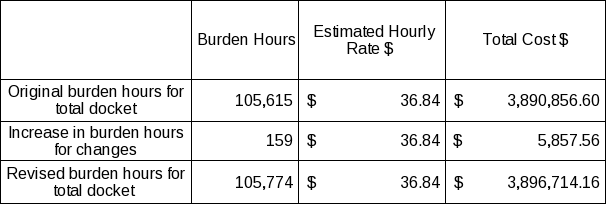
NASS uses the Bureau of Labor Statistics’ Occupational Employment Statistics (most recently published on March 29, 2019 for the previous May) to estimate an hourly wage for the burden cost. The May 2018 mean wage for bookkeepers was $20.25. The mean wage for farm managers was $38.43. The mean wage for farm supervisors was $24.42. The mean wage of the three is $27.70. To calculate the fully loaded wage rate (includes allowances for Social Security, insurance, etc.) NASS will add 33% for a total of $36.84 per hour.
Original Burden Tables
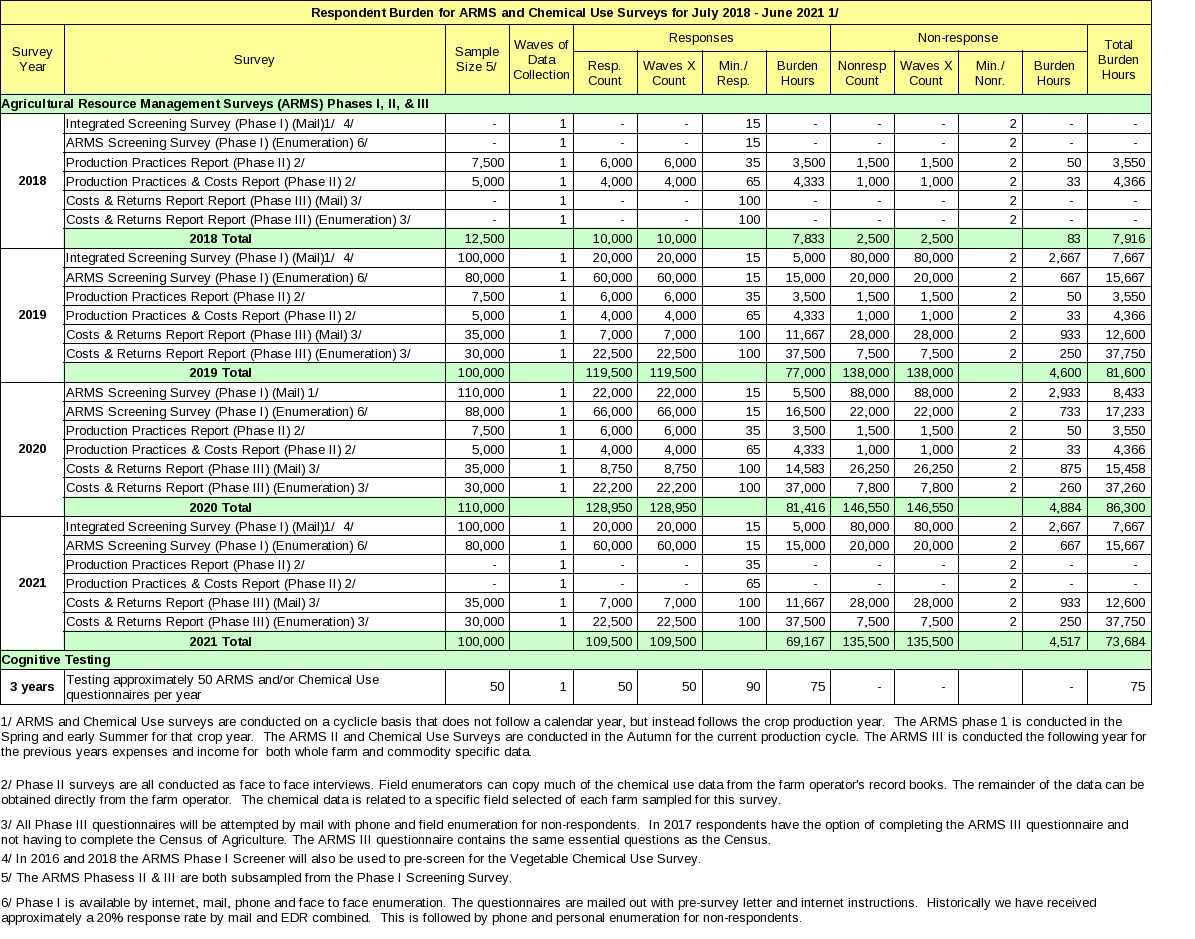
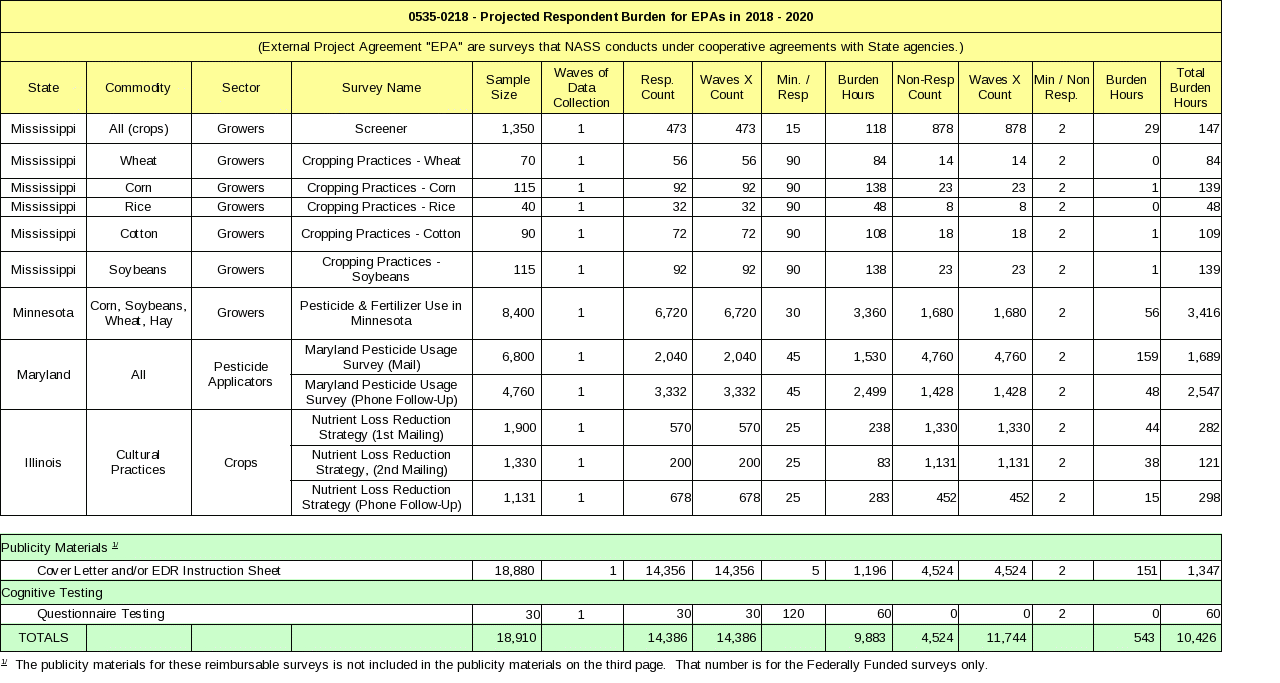
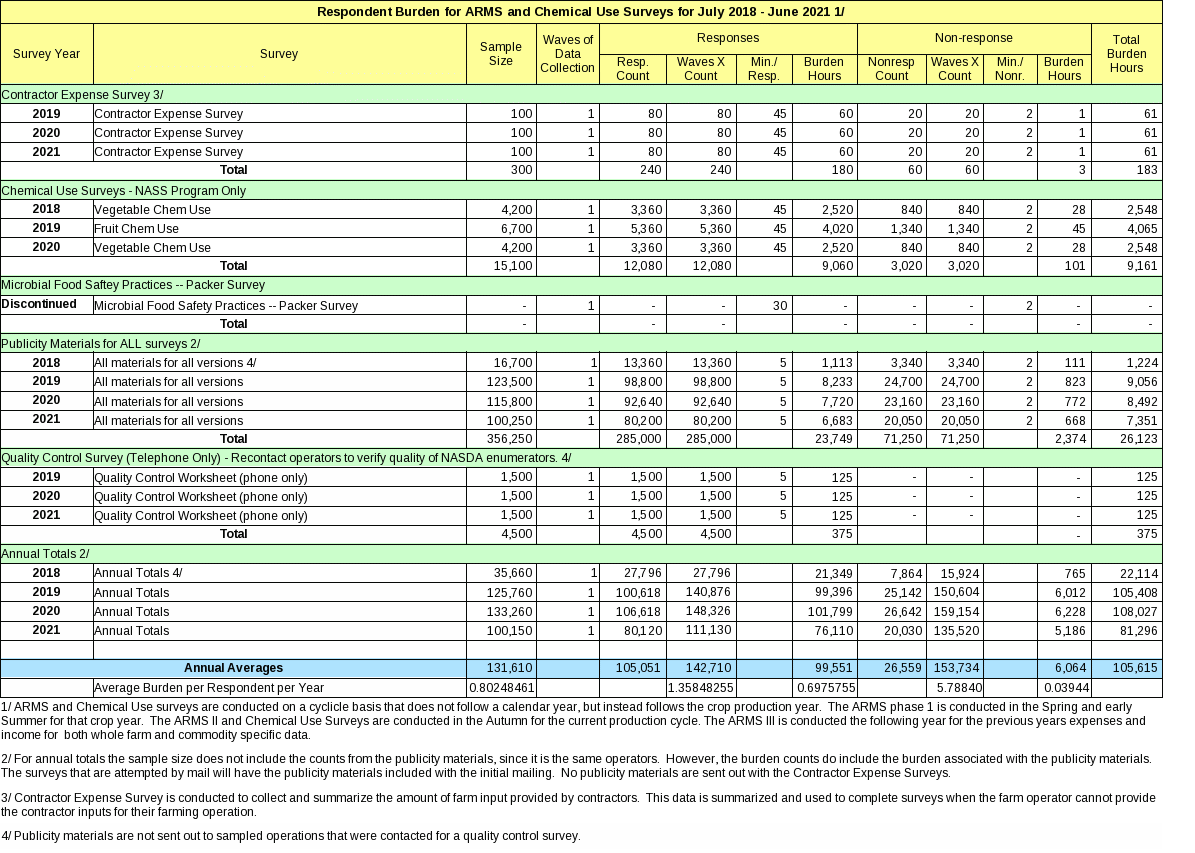 Revisions
Revisions

Total annual cost burden to respondents.
No start-up or ongoing operation/maintenance costs are associated with this information collection.
Annualized costs to federal government.
OPMP provided NASS with $940,000 to cover the costs associated with these changes.
Reasons for changes in burden.
OPMP came to NASS wanting to incorporate additional pest management questions into the ARMS II Production Practices Reports. The PPR surveys for 2019 will be for winter, spring and durum wheat questionnaires, the new questions will be in Section E, Pest Management Practices, questions number 17 – 29. In addition, OPMP requested that similar pest management questions be added to the Fruit Chemical Use Survey which will also be conducted in 2019. The PPR and the fruit questionnaires are already approved to collect data that is related to Pest Management; OPMP needs additional detail to be included in the 2019 questionnaires. The PPR respondent burden was increased from 35 minutes per completed response to 50 minutes and for the Fruit Chemical Use Survey, the respondent burden was increased from 50 minutes to 60 minutes. However the overall sample size was reduced by 1,200. The net change in annual respondent burden is reflected in the table below.
The ARMS II Production Practices and Costs Reports (PPCR) will target the commodities of barley, cotton and sorghum in 2019. NASS conducts these surveys under a cooperative agreement with the USDA Economic Research Service (ERS). Each year, ERS adds or adjusts the questions to accommodate data needs either for research purposes or regulatory guidelines. In 2019, at the request of ERS, several changes have been made to the PPCR questionnaires for barley, sorghum, and cotton. The questions are tested questions that were previously asked on either the soybean or corn PPCR versions. Based on completion times for the corn and soybean PPCR surveys, the added questions and skip patterns are incorporated into the 2019 questionnaires; we are not expecting any increase in respondent burden per completed questionnaire.
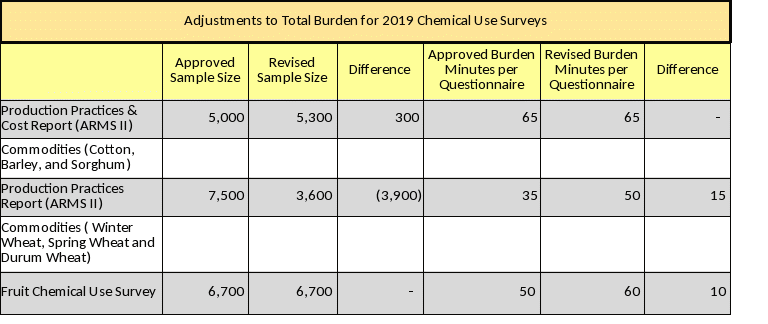
Tabulation, analysis, and publication plans.
NASS will generate a summary of responses for each question at both the state and national level. The published data will be posted to the home page for the Office of Pest Management Policy which can be found at: https://www.ars.usda.gov/office-of-pest-management-policy/office-of-pest-management-policy-home-page/.
Request for approval of non-display of expiration date.
No request is being made for approval of non-display of the expiration date.
18. Exceptions to certification statement.
No exceptions to the certification statement are requested.
June 2019
| File Type | application/vnd.openxmlformats-officedocument.wordprocessingml.document |
| Author | HancDa |
| File Modified | 0000-00-00 |
| File Created | 2022-05-02 |
© 2025 OMB.report | Privacy Policy